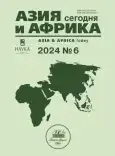Missile Defense of the U.S. and Their Allies in Northeast Asia and Regional Security
- 作者: Krivolapov O.O.1
-
隶属关系:
- ISKRAN
- 期: 编号 6 (2024)
- 页面: 5-14
- 栏目: Politics, economics
- URL: https://journals.rcsi.science/0321-5075/article/view/258969
- DOI: https://doi.org/10.31857/S032150750031033-8
- ID: 258969
如何引用文章
全文:
详细
作者简介
O. Krivolapov
ISKRAN
Email: o.krivolapov@iskran.ru
ORCID iD: 0000-0001-9658-2671
PhD (Political Science), Senior Researcher Moscow, Russia
参考
- Roberts B. 2015. Strategic dead end or game changer? Regional missile defense from a global perspective. Eds: C.M.Kelleher, P.Dombrowski. Stanford: Stanford University Press. Pp. 241–263.
- Arie K., Yamaguchi N. 2018. U.S. Initiative for Integrated Air and Missile Defense. NIDS Journal of Defense and Security. Iss. 19. Pp. 17–36.
- Bennett B. et al. 2021. Countering the Risks of North Korean Nuclear Weapons. Santa Monica: RAND Corporation, The Asan Institute for Policy Studies.
- Heinrichs R. et al. 2022. Defending Guam. Washington, DC: Hudson Institute.
- Postol T., Lewis G. 2016. The Illusion of Missile Defense. Why THAAD Will Not Protect South Korea. Global Asia. Vol. 11. Iss. 3. Pp. 80–85.
- Aoki N. 2017. Seeing missile defense as U.S. hostility, North Korea aims at more and better weapons. Missile defense, extended deterrence, and nonproliferation in the 21st century. Ed. C.M.Kelleher. College Park: CISSM. Pp. 61–70.
- Panda A., Narang V. Deadly Overconfidence: Trump Thinks Missile Defenses Work Against North Korea, and That Should Scare You. War on the Rocks, 17.10.2017.
- Coyle P., McKeon J. A False Sense of Security. U.S. News & World Report. 27.04.2018.
- Дворкин В.З. Влияние систем ПРО на стратегическую стабильность и перспективы ядерного разоружения. Мировая экономика и международные отношения. 2019. № 8, 5–12. doi: 10.20542/0131-2227-2019-63-8-5-12 Dvorkin V.Z. 2019 Impact of missile defense systems on strategic stability and prospects for nuclear disarmament. World Economy and International Relations. Iss. 8. Pp. 5‒12. Moscow. (In Russ.). doi: 10.20542/0131-2227-2019-63-8-5-12
- Криволапов О.О. Дискуссии о роли систем ПРО театра военных действий в региональном сдерживании Северной Кореи и Ирана. Вестник Московского университета. Серия 25. Международные отношения и мировая политика. 2022. № 1, 33–63. doi: 10.48015/2076-7404-2022-14-1-33-63 Krivolapov O.O. 2022. Debates on the role of the U.S. theater missile defense in the regional deterrence of North Korea and Iran. Moscow University Bulletin of World Politics. № 1. Pp. 33–63. Moscow. (In Russ.). doi: 10.48015/2076-7404-2022-14-1-33-63
- Поленова А.Л., Лобов Р.Н. Совместный ситуационный анализ ИДВ РАН и ИСАА МГУ. Проблемы Дальнего Востока. 2017. № 5, c. 168–177. Polenova A.L., Lobov R.N. 2017. Situation analysis by the Institute of Far Eastern studies RAS and MSU Institute of Asian and African Countries. Far Eastern Studies. № 5. Pp. 168–177. Moscow. (In Russ.)
- Sankaran J. 2020. Missile defenses and strategic stability in Asia – evidence from simulations. Journal of East Asian Studies. Vol. 20. Iss. 3. Pp. 485–508. DOI: https://doi.org/10.1017/jea.2020.10
- Kristensen H., Korda M. 2022. Nuclear Notebook: How many nuclear weapons does North Korea have in 2022? Bulletin of Atomic Scientists. Vol. 78. Iss. 5. Pp. 273–294. doi: 10.1080/00963402.2022.210934
- Воронцов А.В. Как воспринимать Закон о политике КНДР в отношении ядерных вооруженных сил? Российский совет по международным делам. 16.09.2022. Vorontsov A.V. How to see the DPRK’s Act on Policy towards Nuclear Armed Forces? Russian International Affairs Council. 16.09.2022.
- Асмолов К.В. КНДР представляет новую ядерную доктрину. Российский совет по международным делам. 14.09.2022. Asmolov K.V. DPRK presents new nuclear doctrine. Russian International Affairs Council. 14.09.2022.
- Kurata H. North Korea’s Supreme People’s Assembly Adopts Nuclear Use Law. The Japan Institute of International Affairs. 13.01.2023.
- Ilbo Hwang. 2021. North Korea’s Nuclear Command and Control Estimate. The Korean Journal of Defense Analysis. Vol. 33. Iss. 4. Pp. 617–638. DOI: https://doi.org/10.22883/kjda.2021.33.4.004
- Bowers I., Hiim H.S. 2021. Conventional Counterforce Dilemmas. South Korea’s Deterrence Strategy and Stability on the Korean Peninsula. International Security. Vol. 45. Iss. 3. Pp. 7–39. DOI: https://doi.org/10.1162/isec_a_00399
- Криволапов О.О. Региональная ПРО США и их партнеров в западной части Тихого океана: влияние на региональную безопасность. Общественные науки и современность. 2023. № 3. С. 39–53. doi: 10.31857/S0869049923030036 Krivolapov O.O. 2023. Regional missile defense architecture of the U.S. and their partners in the Western Pacific: Impact on regional security. Social Sciences and Contemporary World. Iss. 3. Pp. 39–53. Moscow. (In Russ.). doi: 10.31857/S0869049923030036
- Bennett B. Deterrence of North Korean Limited Nuclear Attack. RAND Corporation. 27.11.2023.
- Panda A. 2023. Indo-Pacific Missile Arsenals. Washington, DC: Carnegie Endowment for International Peace.
- Scobell A., Sanford J. 2007. North Korea’s Military Threat: Pyongyang’s Conventional Forces, Weapons of Mass Destruction, and Ballistic Missiles. Carlisle: U.S. Army Strategic Studies Institute.
- Cordesman A. 2016. Korean Missile Forces. Washington, DC: Center for Strategic and International Studies.
- Ланьков А.Н. Северная Корея окончательно стала ядерной державой: что дальше? Международный дискуссионный клуб «Валдай». 28.04.2022. Lankov A.N. North Korea finally became a nuclear power: What next? Valdai Discussion Club. 28.04.2022.
- Coyle P. US builds missile defense system for South Korea, causing more tension. The Hill. 18.03.2017.
- Panda A. South Korea’s “Decapitation” Strategy against North Korea has more Risks than Benefits. Carnegie Endowment for International Peace. 15.08.2022.
- Золотарев П.С. Ядерные аспекты военной политики и российско-американские отношения. Россия и Америка в XXI веке. 2019. Вып. 1. doi: 10.18254/S207054760004694-0. https://rusus.jes.su/s207054760004694-0-1/ (accessed 12.06.2020). Zolotarev P.S. 2019. Nuclear Aspects of Military Policy and Russian-American Relations. Russia and America in the 21st Century. Iss. 1. (In Russ.). doi: 10.18254/S207054760004694-0. https://rusus.jes.su/s207054760004694-0-1/ (accessed 12.06.2020)
- Weitz R. 2020. Strengthening Multi-Domain Deterrence and Defense in the Asia-Pacific Region. The Korean Journal of Defense Analysis. Vol. 32. Iss. 4. Pp. 495–516. DOI: https://doi.org/10.22883/kjda.2020.32.4.001
- Jervis R. 1982. Deterrence and Perception. International Security. Vol. 7. Iss. 3. Pp. 3–30.
- Schelling T. 2008. Arms and Influence. New Haven: Yale University Press.
- Lieber K., Press D. 2017. The New Era of Counterforce. International Security. Vol. 41. Iss. 4. Pp. 9–49. doi: 10.1162/ISEC_a_00273
补充文件










